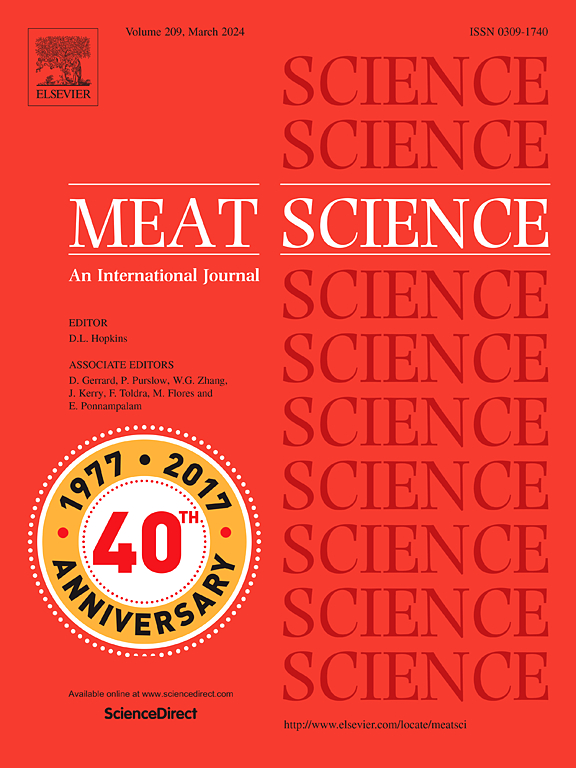Animal welfare and meat quality: The impact of on-farm slaughter on Cinta senese pigs
IF 6.1
1区 农林科学
Q1 Agricultural and Biological Sciences
引用次数: 0
Abstract
This study evaluated the effects of on-farm slaughter (OF) compared to traditional slaughter (TS) on animal welfare, meat quality, and microbiological safety in Cinta senese pigs reared outdoors. Forty pigs were slaughtered using both methods across different seasons, allowing for the analysis of environmental influences via the Temperature-Humidity Index (THI). Blood parameters (cortisol, LDH, CPK), carcass and meat microbial loads, and technological meat quality traits were assessed.
Pigs slaughtered on-farm showed significantly lower levels of cortisol, LDH, and CPK, indicating reduced physiological stress. Meat from these animals also had a lower pH 24 h post-mortem, suggesting improved glycolytic activity and better preservation of quality traits. Microbiological analysis showed no significant differences between the two methods, with all carcasses remaining within safety thresholds, although mesophilic counts tended to be lower in OF carcasses. Environmental conditions, especially THI in the two weeks before slaughter, affected some microbial loads in meat but not in carcasses.
The results demonstrate that OF slaughter is a viable alternative that can significantly reduce animal stress and maintain both meat quality and microbiological safety, offering a sustainable and ethical option for small-scale or pasture-based pig farming.
动物福利与肉质:猪场屠宰对信义猪的影响
本研究评估了猪场屠宰(of)与传统屠宰(TS)对室外饲养的中国猪的动物福利、肉品质和微生物安全的影响。在不同季节使用这两种方法屠宰40头猪,允许通过温度-湿度指数(THI)分析环境影响。评估血液参数(皮质醇、LDH、CPK)、胴体和肉类微生物负荷以及肉质技术性状。在农场屠宰的猪表现出较低的皮质醇、LDH和CPK水平,表明生理应激降低。这些动物的肉在死后24小时的pH值也较低,这表明糖酵解活性提高,品质性状得到了更好的保存。微生物学分析显示两种方法之间没有显著差异,所有尸体都保持在安全阈值内,尽管在OF尸体中嗜温菌计数往往较低。环境条件,特别是屠宰前两周的THI,影响了肉中的一些微生物负荷,但对胴体没有影响。结果表明,OF屠宰是一种可行的替代方法,可以显著减少动物压力,保持肉质和微生物安全,为小规模或牧场养猪业提供可持续和道德的选择。
本文章由计算机程序翻译,如有差异,请以英文原文为准。
求助全文
约1分钟内获得全文
求助全文
来源期刊

Meat Science
工程技术-食品科技
CiteScore
12.60
自引率
9.90%
发文量
282
审稿时长
60 days
期刊介绍:
The aim of Meat Science is to serve as a suitable platform for the dissemination of interdisciplinary and international knowledge on all factors influencing the properties of meat. While the journal primarily focuses on the flesh of mammals, contributions related to poultry will be considered if they enhance the overall understanding of the relationship between muscle nature and meat quality post mortem. Additionally, papers on large birds (e.g., emus, ostriches) as well as wild-captured mammals and crocodiles will be welcomed.
 求助内容:
求助内容: 应助结果提醒方式:
应助结果提醒方式:


